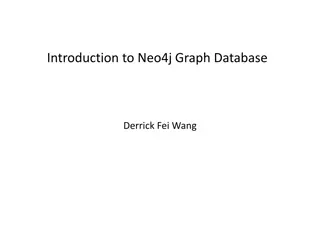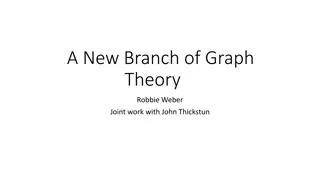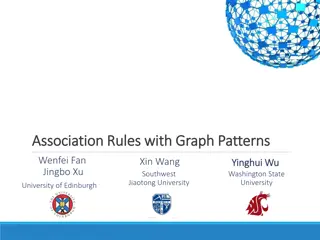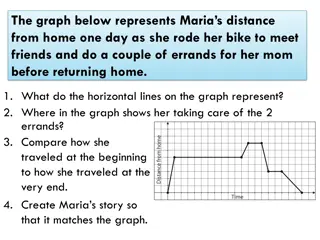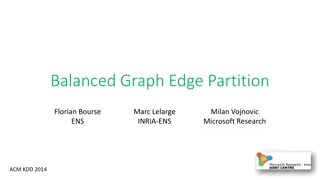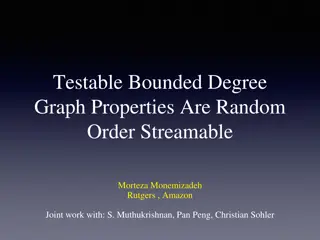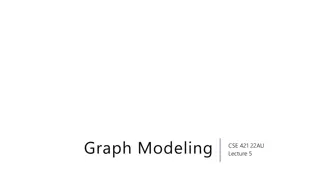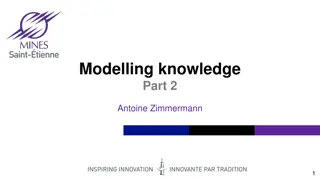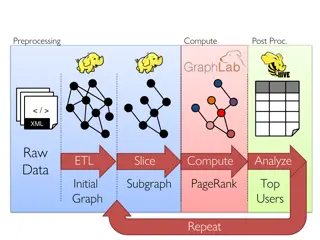
Elementary Graph Algorithms Overview and Representations
Explore the fundamentals of graph algorithms including graph definition, representation via adjacency list and matrix, and elementary search algorithms like breadth-first search (BFS) and depth-first search (DFS). Learn about topological sort, strongly connected components, and more in Chapter 22.
Download Presentation

Please find below an Image/Link to download the presentation.
The content on the website is provided AS IS for your information and personal use only. It may not be sold, licensed, or shared on other websites without obtaining consent from the author. If you encounter any issues during the download, it is possible that the publisher has removed the file from their server.
You are allowed to download the files provided on this website for personal or commercial use, subject to the condition that they are used lawfully. All files are the property of their respective owners.
The content on the website is provided AS IS for your information and personal use only. It may not be sold, licensed, or shared on other websites without obtaining consent from the author.
E N D
Presentation Transcript
Chapter 22: Elementary Graph Algorithms Overview: Definition of a graph Representation of graphs adjacency list matrix Elementary search algorithms breadth-first search (BFS) depth-first search(DFS) topological sort strongly connected components
Notation Graph G(V,E) is a data structure defined by a set of vertices V a set of eges E |V| = # of vertices |E| = # of edges Usually omit | | in asymptotic notation (V, E) means (|V|, |E|)
Adj = adjacency-list representation of G(V,E) is an array of |V| lists Adj[u] contains all vertices adjacent (connected by edges) to vertex u For a directed graph, edge (u v) represented by v in Adj[u]. sum of lengths of adjacency lists = |E| For an undirected graph, edge (u,v) appears as v in Adj[u] and as u in Adj[v]. sum of lengths of adjacency lists = 2|E| Memory requirement is (V+E) A weighted graph has a function w(u,v) defined on the domain E. The weight of edge (u,v) can be stored as property of vertex v in Adj[u].
adjacency-matrix representation: Number the vertices 1,2,...|V| Define |V| x |V| matrix A such that aij = 1 if (i, j) E, aij = 0 otherwise For a weighted graph, set aij = w(i,j) if (i, j) E Disadvantage is requires (V2) memory regardless of |E| Advantage is speed of determining if edge (u,v) is in graph For an undirected graph A is symmetric A sparse graphs mean |E| << |V|2 adjacency-list representation preferred (saves space) A dense graph means |E| ~|V|2 adjacency-matrix representation preferred (speed)
Breadth-first search: Given G(V,E) and a source vertex s, Breadth-first search does the following: (1) finds every vertex v reachable from s (2) calculates distance (minimum number of edges) between s and v (3) produces a Breadth-first tree with s as the root and every reachable vertex as a node The path from s to v in the Breadth-first tree corresponds to the shortest path between s and v in G. Breadth-first finds all vertices at distance k from s before searching for any vertices at distance k+1.
BFS(G,s) pseudo code for each u V(G) {s} do color[u] white, d[u] , [u] NIL (Initialization: color all vertices white for undiscovered set distance from s as infinite, set predecessor in Breadth-first tree to NIL) color[s] gray, d[s] 0, [s] NIL (initialize s as gray for discovered i.e. reachable from s A gray vertex has been discovered but its adjacency list has not been searched for links to other vertices. After adjacency list is searched, color is changed to black) Q 0, Enqueue(Q,s) (A first-in first-out queue holds a list of the current gray vertices Gray vertices with the smallest distance from s are processed first
BFS(G,s) algorithm continued while Q 0 do u Dequeue(Q) for each v Adj[u] color[u] black (adj list searched) do if color[v] = white then color[v] = gray d[v] d[u] + 1 [v] u Enqueue(Q,v) Runtime analysis: initialization requires O(V). each vertex is discovered at most once queue operations require O(V). searching adjacency lists requires O(E) total runtime O(V+E)
Example of BFS (p596) using pseudo-code How would this result be different if x was dequeued before t?
Predecessor of v: (v) is the vertex in whose adjacency list v was discovered Predecessor sub-graph G (V ,E ) V = {v V : [v] NIL} {s} E = {( [v],v) : v V - {s}} Predecessor sub-graph of BFS is a single tree How would this tree be different if x was dequeued before t?
BFS by hand: Unnecessary to perform all steps of pseudo-code Find all vertices at distance k from s before searching for any vertices at distance k+1. Resolve ambiguities about which adjacency list to search next by alphabetic order Mark the edges used in a search with a T for tree edge. Keep a record of parentage. Simple example t s 0 v u
BFS by hand: When a new vertex is discovered enter number one greater than the parent. Resolve ambiguities about which adjacency list to search next by alphabetic order Example: u can be discovered from either t or v. Choose t Mark the edges used in a search with a T for tree edge. Keep a record of parentage. t s T 0 1 T 1 v u
BFS by hand: With ambiguity resolved by alphabetical order, edge (t,u) becomes a tree edge rather than (v,u) t s T 0 1 T T 2 1 v u
Finding shortest path is most common application of Breadth-first search If a vertex is reachable from the source, the integer in each vertex, (s, ), is the length in edges of the shortest path from the source. (s, ) = if is not reachable from s t s T 0 1 T T 2 1 v u
Weight of a path Weight of a path is the sum of the weights of its edges For an unweighted graph, weight of path = number of edges = length of path For weighted graph, least-weight is not necessarily shortest path
Theorem 22.5:On termination of BFS(G,s), (1)all reachable vertices have been found (2) d[v] = (s,v) for v V (some may be infinite) (3) for any reachable v s, a shortest path includes [v] followed by edge ( [v],v).
Assignment 16 Ex 22.2-2 text p 601. Perform BFS. Use alphabetical order to resolve ambiguity in order of discovery. Mark tree edges. Make a table of [v] for all v. Draw G Note: u is the source vertex





